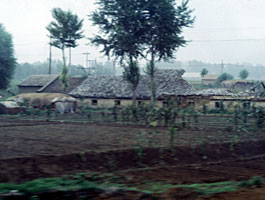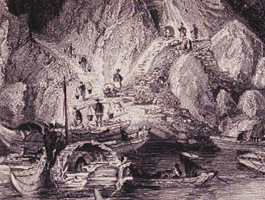China and Europe: 1780-1937
What Happened?
Ecological Differences

Workers at the mouth of an English coal pit, early nineteenth century.
Avery Architectural and Fine Arts Library, Columbia University
Now, an obvious question arises: Why don't these similarities last? We know that they don't. Between 1750 and 1900, European production and living standards were transformed, while Chinese non-grain consumption actually seemed to decline a bit. Nineteen hundred figures for cloth and sugar, for instance, come out below even my lower-bound estimates for 1750. Why would that be? What happened?
Much of the difference was ecological, but not in the simple sense that population pressure produced any more serious problems within Chinese cores than in core areas of Europe. That view— that there were simply too many people in China, et cetera—is a standard warhorse of the literature.
But at least for the most advanced regions of China, the story doesn't seem to hold. And the most advanced regions were also the most densely populated. I've reconstructed just for one example, nitrogen fluxes from dry farming areas of North China and England. Nitrogen is the limiting nutrient in most early modern farming, and fortunately it's also somewhat easier to reconstruct what happens with that than with most other nutrients.

Farming village, Hebei Province, China, 1980s
© Karen Kane
Again, even more than with most numbers, these have to be taken with grains of salt. We can talk about where they came from, but they show circa 1800 that there's no reason to assume more severe soil depletion in China than in England. And that does not necessarily mean that we should say everything was fine in China nor that English farming was on the verge of a crisis. But it means that we have no particular reason to assert that one of them was fine and the other was in trouble.
China's Internal Markets [VIDEO]
TRANSCRIPT: These are, for those of you not in the China field, primarily rice and timber coming down the Yangzi, soybeans coming down the coast from Manchuria, raw cotton coming down from north China, and so on and so forth, and mostly cloth going back in the other direction to pay for these things.
Over the longer haul though, the freer trade of advanced Chinese regions with its, with their interior, also hits limits. With families in peripheral areas more or less free to allocate their labor, the export boom stimulated population growth, (by) both natural increase and immigration, in places like north China and the middle Yangzi over the course of the eighteenth and early nineteenth century.
And as the best land filled up, some laborers switched to handicrafts, reducing raw material surpluses for export and demand for imported textiles. What had been by far the world's largest long-distance staple trade began to decline. And the terms of trade shifted sharply against manufacturers. This constrained the development of the core regions. The population of the Yangzi delta was flat from 1770 to 1850. No increase at all, while China as a whole is roughly doubling.
China's nineteenth-century decline in per capita consumption that I mentioned earlier was probably quite small in most regions, and so attracted little notice. We don't have literati in 1850 saying, "Gee, everybody's got less of everything than they had when I was a boy." And the reason for this, I think, is simply that individual regions were probably not for the most part experiencing declines.
Resource Differences
Archaeology, agricultural-yield data, and increasing reports of sandstorms all point to serious soil degradation in various Western European regions during the eighteenth century. Forest cover declined dramatically in the early modern period, and so on. But then, many of these indicators actually stabilize in the nineteenth century, amid the much-faster population and economic growth of that period, which is, at first blush, exactly what you would not expect.
If there are more people, and they are each consuming more resources, you would expect things to get considerably worse. Of course, in certain ways like air pollution, they did, but other crucial indicators stabilized. A contrast both to what we would expect, and as we'll see, to what happened in East Asia, where far less impressive growth leads to far worse ecological decline in the nineteenth century.

A mid-nineteenth-century European depiction of a Chinese coal mine.
Avery Architectural and Fine Arts Library, Columbia University
Fossil Fuels and the Steam Engine
How could this happen? Part of the answer is the transition in Western Europe to fossil fuels. Above all, there was coal, each ton of which equaled the sustainable timber yield from 1 to 1.5 acres of prime mid-latitude forest. But Chinese coal deposits were just too many landlocked miles away from its core regions to be economical before railways, no matter what breakthroughs in extraction use occurred. And mines so far from concentrations of skilled artisans were not well positioned for technological change anyway. Also, inconsistent government policies toward mining based on fear of groups of single males didn't help either. The Chinese still preferred that mines be small.
Of course, there's nothing new about noting the importance of coal and the steam engine. If anything, older accounts of industrialization stress them even more than most current ones do. What is less often remarked is how dependent they were on each other. Without steam engines to pump water out of the mines, it's quite likely that English coal production would have stagnated at 1700 levels—which were high by world historical standards, but only about one-tenth of what production would reach by 1830. And while early steam engines were very good for performing this job, they weren't good for much else. They were bulky, dangerous, and extremely inefficient, turning only one to two percent of the energy they used into actual power. They were so inefficient that they were really only worth using at the mine itself, where fuel was virtually free. (Most of the cost of coal was the cost of transporting it, which was extremely high unless you happened to be right on the water.) Indeed, despite many improvements made over the previous century, as late as 1800 almost all steam engines were still in coal mines. If not for their use in the mines, the steam engines might not have been considered worth tinkering with and developing further. So while technological creativity was certainly important in this breakthrough (how could it not be?), so was an important combination of more or less accidental circumstances: a very heavily deforested England, the presence of lots of coal, including outcroppings on the surface, which people had gotten used to using over the years; mines, which, as people got past the easy coal and had to dig deeper, kept filling up with water, but which were also located within easy reach of a fuel-hungry metropolis; and lots of skilled artisans, who made incremental improvements on the original steam engine, eventually making it safe and efficient enough to mount on wheels, use in factories, and change the world. Without this combination of factors, the early steam engine might not have gone past being a interesting but rather uneconomical curiosity, a fate which seems to have befallen it in some other times and places.
Europe Turns to the New World
Along with the fossil-fuel revolution, northwestern Europe also benefited from soaring imports from land-rich regions, especially in the New World. As their demand for food, clothing fiber, building materials, and fuel—Malthus' famous four necessities—mounted, cores everywhere found themselves needing to acquire these land-intensive products by trading with a periphery that would buy the core's manufacturers.
But that had its limits. In eastern Europe for instance, with many barriers to factor mobility and much of the population outside the cash economy, the response to external demand was comparatively muted. And though much is made of the Baltic trade and the beginnings of an international division of labor, it actually had plateaued by 1650, at a fraction of the size of China's long-distance staple trades.
The New World: Both Periphery and Market
The New World, however, was a different kind of periphery from any of those that I've sketched, within Eurasia at either end. Smallpox and other disasters depopulated it. And much of the labor force was replaced by slaves, who were purchased from abroad. Moreover, New World slaves, on the whole, engaged in less subsistence production than did most coerced cash-crop workers in the Old World.

The New World: Both Periphery and Market
Courtesy Jean Elliott Johnson
Thus despite their poverty, they formed a significant market for coarse cloth and other manufactures. Consequently, the circum-Caribbean slave region from Brazil to what becomes the U.S. South became in a sense the first modern periphery, with large bills to pay for imported capital gains and a pretty large market for mass consumer goods. And so, unlike Old World peripheries, the New World kept expanding as a source of land-intensive exports for Europe. Together, mining in the New World allowed big chunks of northwestern Europe to have a population boom, specialize more in manufacturing, and consume more per capita, without facing either primary-product shortages or further ecological deterioration of farmland.